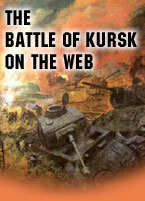
Major Topics
Defense | Armor | Soviet Perspectives | Air War | Personal Accounts | Monuments and Commemoration | Analysis
Soviet War monuments, including to the Battle of Kursk. High communist ideological content, from the Voice of Russia's The Road to Victory 1941-1945.
Defense
Mine and Countermine Operations in the Battle of Kursk. Report by the U.S. Army Communications-Electronics Command (2000). This is an extremely lengthy article. The first chunk is a solid and readable review of the situation of the Eastern Front and around the Kursk salient, and the body contains a detailed narrative of the engagement. Nevertheless, the goal is to detail and understand Soviet mine defences and the German response. Soviet mines are judged highly effective:
"The delays the minefields imposed on the German attacks were probably at least as important as the losses they inflicted. Each minefield they encountered caused the German attackers to stop and wait for engineers to clear lanes -- usually by hand."Study put on the web by Sappers Forward!. You can also buy a printed copy of the report.
Armor
PanzerDiesel by Ingbert Corbé, a Panzer omnigatherum. There's little on Kursk pe se, but you can get statistics and lists of commanders for every tank unit. Start with the Sitemap.
Photographs of destroyed Axis and Soviet tanks and other armored vehicles, many at Kursk, from Russian Battlefield.
 Amazon. Encyclopedia Of German Tanks Of World War Two by Peter Chamberlain and Hilary Doyle.
Amazon. Encyclopedia Of German Tanks Of World War Two by Peter Chamberlain and Hilary Doyle.
Pages about the Soviet SU-122 Assault Gun, SU-152 Assault Gun (which first saw service at Kursk), the T-34, and
Losses of Soviet Tank Armies and Corps in 1942-1945 statistics collected by Michael Svirin Russian Battlefield.
 Amazon. Russian Tanks of World War II: Stalin's Armored Might by Tim Bean, Will Fowler
Amazon. Russian Tanks of World War II: Stalin's Armored Might by Tim Bean, Will Fowler
"Necessary Observations Regarding the Comparison of Tanks" an excellent methodological article by Valeriy Potapov, translated by James F. Gebhardt. Concludes:
"A tank is too expensive an item to be used simply as an anti-tank weapon. Both in the Soviet and German armies the destruction of tanks was assigned first of all to anti-tank, field, and self-propelled artillery. Tanks were advised, conversely, to avoid direct engagements, since this led to unjustified losses. It was recommended to operate only from cover and ambush, and only in the concluding phase of the war did the Germans, clearly having lost the war, change their tactics. This did not help but only increased their losses. German and Soviet design engineers, like the engineers of all countries, compared tanks not to establish "the best over the best", but to discern their strength and weaknesses and understand what an obvious or potential enemy possesses. Such a comparison is useful for domestic tank design and production. What is the purpose in endless arguments by amateurs, overwhelming numbers of whom have never been in a tank, and many have not once seen a tank up close?"
Soviet Perspectives
"Soviet Defensive Tactics at Kursk, July 1943" by Col. David M. Glantz for the Combat Studies Institute (1986), also available in PDF format, scanned from a typewritten copy. (The charts and other figures are broken in the HTML.) Described and recommended by Mike Licari (at bottom).
"[A] 70 page analysis of how the Soviets established their defense in the Kursk bulge. It is incredibly detailed, building from the lowest levels (individual battalion positions), up through regiments, divisions, corps, armies, and fronts. Thus, it assesses the tactical, operational, and strategic levels, and is a handy companion to the Soviet General Staff Study edited by Glantz and Orenstein."
Artillery density at Kursk Battle by July 4, 1943 from a 1998 Russian book on Kursk, courtesy Russian Battlefield.
List of Soviet Armies and their HQs at Kursk Battle from a 1998 Russian book on Kursk, courtesy Russian Battlefield.
Prelude to Kursk: Soviet Strategic Operations February-March 1943 from Russian Battlefield.
"In the end, the Stavka's February-March offensive was a bold gamble that failed, and the expected victory turned into embarrassing defeat. The price of that boldness was the loss of 500,000 Red Army soldiers. While the Stavka succeeded in stabilizing the situation on March, it would be seven months before the Red Army would reach the Dnieper to stay. To do so would require the Battle of Kursk, the most immense Red Army strategic offensive effort to date, and the sacrifices of another 3.5 million Red Army soldiers."
Partial translation of a 1943 Russian paper "The Battle at Prokhorovka" by G.A. Oleinikov, from Alex's RKKA in The World War II.
Air War
"Greatest Tank Battle in History: The greatest tank battle in history began with an air battle" from the HistoryNet.
Air Operations during the Battle of Kursk (July–August 1943), compiled by Pawel Burchard. Detailed orders of battle.
Soviet "Circle of Death" tactic against German armor.
Personal Accounts
Interview with Zhuravlev Alexander Grigoryevich, Lieutenant and Hero of the Soviet Union, who took part in Kursk. Much of the interview is about other battles, but there are some good Kursk annecdotes too. From The Road to Victory 1941-1945.
Soviet Medic: Natalia Peshkova. Kursk is just a paragraph, but this is a great read. With all the talk of tanks, you might not imagine typhus and lice.
"There was typhus during the hard battles near Kursk. … Lice were awfully widespread. We used the breaks between the battles to clean our clothes with heat in self-made saunas. On the bank of the Ugra River, I vaccinated our soldiers against diphtheria and tetanus. I just went through the trenches and vaccinated everybody, one by one. Once I figured that I was on the front for three years and three months."From I Remember (Soviet war accouts)
Monuments and Commemoration
Pravda on the 60th anniversary celebrations (August 8, 2003) and here (shorter).
Analysis
The Battle of Kursk: An Analysis of Strategic and Operational Principles by German Colonel Bruno Kasdorf, a "Research Strategy Project" (ie., term-paper?) for the U.S. Army War College.
"Studying the battle of Kursk or comparing Kursk to Kharkov shows a student of military affairs how through inappropriate strategy and ignoring basic principles of war only poor results can be produced.""From The Black Vault, which puts government documents online.

If you enjoy this site you may like these other sites by me:
D-Day on the Web. Everything about the allied invasion of Normandy, June 6, 1944.
Andrew Jackson on the Web. The ultimate resource on "Old Hickory," President Andrew Jackson.